SQL Basics: A Guide for Students and Beginners(2)
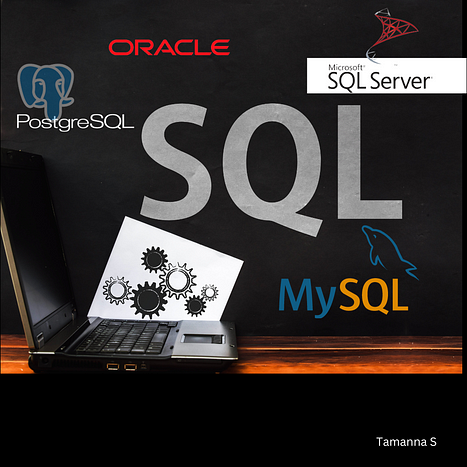
SQL is a powerful and popular language for working with databases. SQL stands for Structured Query Language, and it allows you to create, manipulate, and query data in various database systems such as MySQL, Oracle, PostgreSQL, and more. In this blog post, I will introduce you to some of the basic concepts and commands of SQL that you need to know as a student or a beginner. By the end of this post, you will be able to write simple SQL queries to perform common tasks such as selecting, filtering, sorting, and aggregating data. You will also learn how to use some of the keywords and clauses that are essential for writing effective SQL queries.

SQL Statements
A SQL statement is a command that tells the database what to do. SQL statements are composed of keywords, clauses, expressions, and operators that follow a specific syntax. For example, the following SQL statement selects all the records from a table called Customer:
SELECT * FROM Customer;
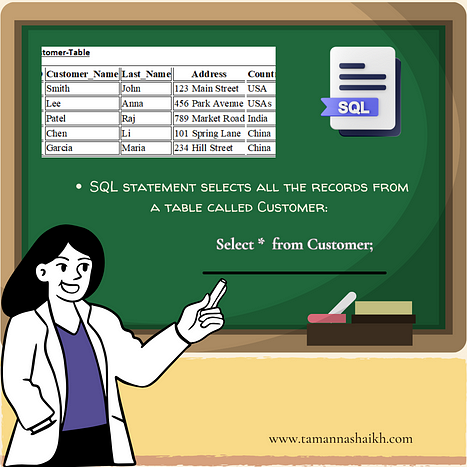
SELECT keyword specifies which columns to return, the FROM keyword specifies which table to query, and the semicolon (;) marks the end of the statement. Note that SQL is not case-sensitive, but it is a good practice to write keywords in uppercase and table and column names in lowercase.WHERE Clause
The WHERE clause is used to filter the records based on a condition. The condition can be a logical expression that evaluates to true or false. For example, the following SQL statement selects only the customer who live in India:
SELECT * FROM Customer WHERE Country = ‘India’;
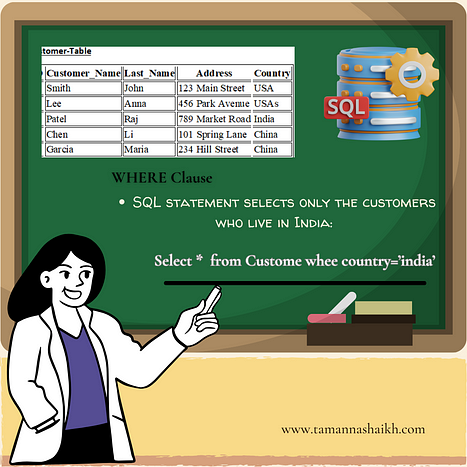
The = operator compares the values of the Country column with the string ‘India’. You can use other operators such as <, >, <=, >=, <>, LIKE, IN, BETWEEN, etc. to create more complex conditions. You can also use the AND, OR, and NOT keywords to combine multiple conditions. For example, the following SQL statement selects the customer who live in India or China and have a name that starts with ‘A’:
SELECT * FROM Customer WHERE (Country = ‘India’ OR Country = ‘China’) AND Name LIKE ‘A%’;
The LIKE operator is used to match patterns using wildcards. The % wildcard matches any sequence of characters, while the _ wildcard matches any single character. The parentheses are used to group the conditions and determine the order of evaluation.
ORDER BY Clause
The ORDER BY clause is used to sort the records in ascending or descending order based on one or more columns. The default order is ascending, but you can use the ASC or DESC keywords to specify the order. For example, the following SQL statement selects all the customer and sorts them by name in ascending order and by age in descending order:
SELECT * FROM Customer ORDER BY Name ASC, Age DESC;
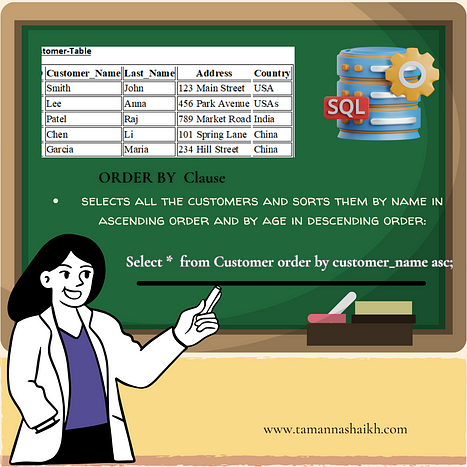
ORDER BY clause should be placed after the WHERE clause if both are present.LIMIT and OFFSET Clauses
The LIMIT and OFFSET clauses are used to limit the number of records returned by a query. The LIMIT clause specifies the maximum number of records to return, while the OFFSET clause specifies the number of records to skip before returning the results. For example, the following SQL statement selects the first 10 customer:
SELECT * FROM Customers LIMIT 10;
The following SQL statement selects the next 10 customer after skipping the first 10:
SELECT * FROM Customer LIMIT 10 OFFSET 10;

LIMIT and OFFSET clauses are useful for implementing pagination or fetching a subset of data.DISTINCT Keyword
The DISTINCT keyword is used to eliminate duplicate records from the result set. It can be applied to one or more columns. For example, the following SQL statement selects the distinct countries of the customer:
SELECT DISTINCT Country FROM Customer;
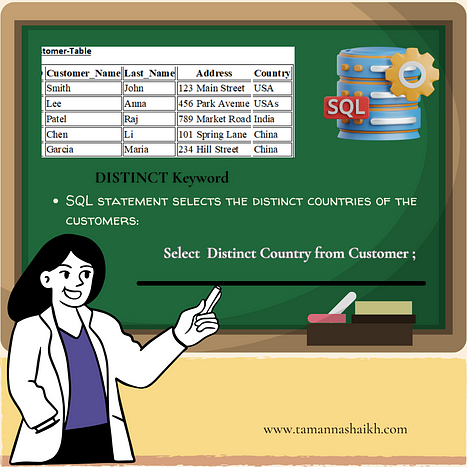
DISTINCT keyword should be placed after the SELECT keyword and before the column names.Conclusion

In this blog post, you learned some of the basic concepts and commands of SQL that are essential for working with databases. You learned how to use the SELECT, WHERE, ORDER BY, LIMIT, OFFSET, and DISTINCT keywords and clauses to create simple SQL queries. You also learned how to use operators, expressions, and wildcards to create and filter conditions.
SQL is a vast and rich language that has many more features and functionalities that you can explore and master. If you want to learn more about SQL in detail, check out my ebook SQL for Students on Gumroad. It covers everything from the basics to the advanced topics of SQL, such as joins, functions, views, procedures, etc., and more with examples of syntax. Resources for more exercises to help you practice and improve your SQL skills.
you can check out some of the following links and resources:
- SQL Introduction — W3Schools: A tutorial that covers the basics of SQL and its syntax
- SQL — Overview — Online Tutorials Library: A tutorial that describes what SQL can do and how it works with RDBMS
- Introduction to SQL (Structure Query Language) | Study tonight: A tutorial that introduces the concepts and history of SQL and its applications.
I hope you enjoyed this blog post and found it useful and informative. If you did, please like this post, share it with friends, and follow me here and linkedin. You can also join the SQL series learning community and get access to more SQL tutorials, tips, and resources. Thank you for reading and happy learning!
Good Note: How to Ace Your Tech Interviews with DesignGurus.

DesignGurus.io is a one-stop portal for tech interviews, offering courses on system design and coding patterns. Whether you are a beginner or a seasoned professional, you can find relevant material to level up your skills and land your dream job in Microsoft, Meta, Google, and Amazon. The courses are designed by experienced engineers from FAANG companies, who also provide mock interviews and feedback. One of the most popular courses is Grokking the Coding Interview, which teaches you how to solve coding problems using patterns. If you are interested in learning more, you can visit the website here and check out all courses here and here.
Comments
Post a Comment